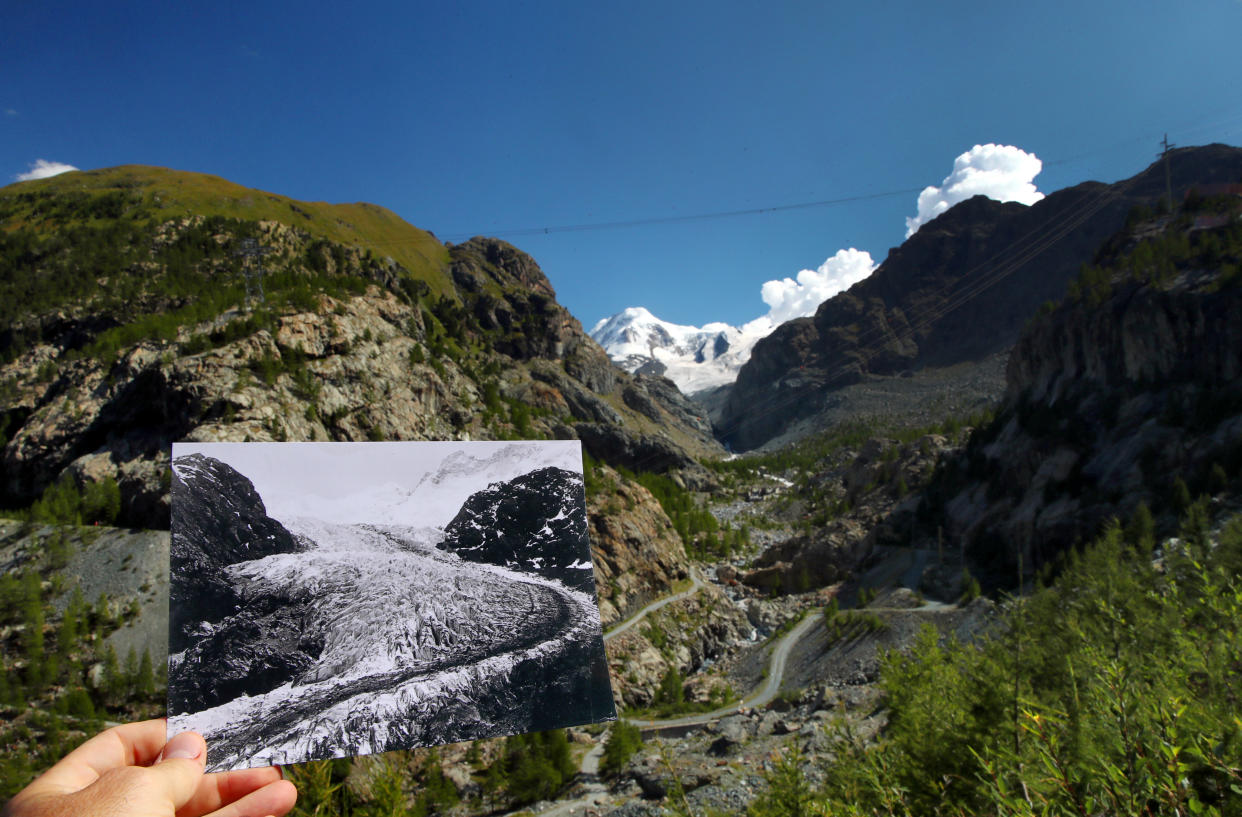Then and now: Swiss glacier photos show impact of global warming

FURKA PASS, Switzerland — On the hairpin bend of a Swiss mountain pass, a Victorian-era hotel built for tourists to admire the Rhone Glacier has been abandoned now that the ice has retreated nearly 1.2 miles uphill.
Where mighty glaciers once spilled into Swiss valleys like frozen rivers of ice, a residue of gray scree and boulders remains, spliced through with raging streams.
A collection of images — showing photos of modern-day mountain landscapes next to archive shots of the same scenes decades earlier — reveals the dramatic change.
More than 500 Swiss glaciers have already vanished, and the government says 90 percent of the remaining 1,500 will go by the end of the century if nothing is done to cut emissions.
Their retreat is expected to have a major impact on water levels — possibly raising them initially as the ice melts but depleting them long term. Officials fear the changes could trigger rockfalls and other hazards and affect the economy.
The Belvedere Hotel, built in the 1880s during a surge in Alpine tourists, was an early victim of the decline. Once the scene of wild parties, it features in a James Bond car chase in “Goldfinger.”
Visitors can still walk into a cave carved into the glacier. But the ice above is now draped with huge white sheets to reflect the sun’s heat. Despite such efforts, meltwater has formed a green lake.
Down the valley, a mid-19th-century photograph shows the glacier’s bulging snout more than 100 meters thick. Now animals graze and a river meanders on the same spot.
In another archive photograph taken in the late 19th century in front of the Aletsch Glacier — the largest in the Alps — a man sits on a boulder in front of a huge ice channel that merges with the main ice stream below. Today they no longer join.
Landlocked Switzerland is warming at twice the global rate, and over the last year its glaciers have lost 2 percent of volume, said Mathias Huss, who heads Switzerland's glacier monitoring institute, GLAMOS, which has data stretching back 150 years.
“We have never seen such a fast rate of glacial decline since the measurements have started,” he said.
Some hope that politics can make a difference, especially after the Green party surged in an October election.
The Glacier Initiative, calling for more climate measures, collected more than the 100,000 signatures required to trigger a referendum and will be sent to Bern this week.
But the glaciers will keep shrinking, scientists say. “The Alps will still be beautiful in my opinion, but they will be different,” Huss said. (Reuters)
See more news-related photo galleries and follow us on Yahoo News Photo Twitter and Tumblr.
_________________
Drag the slider across each pair of images to see changes in the last year.
The Aletsch Glacier at the Eggishorn
1877: The Aletsch Glacier is pictured from the Eggishorn between 1860 and 1877 in Fieschertal, Switzerland. (Photo: Adolphe Braun/Glaziologische Kommission der Akademie der Naturwissenschaften Schweiz/ETH Library Zurich/Handout via Reuters)
2019: People sit above the Aletsch Glacier, Sept. 4, 2019. (Photo: Denis Balibouse/Reuters)
_________________
The Aletsch Glacier in Belalp
1865: The Aletsch Glacier in Belalp, Switzerland, pictured in 1865. (Photo: Adolphe Braun/Glaziologische Kommission der Akademie der Naturwissenschaften Schweiz/ETH Library Zurich/Handout via Reuters)
2019: The Aletsch Glacier, Sept. 3, 2019. (Photo: Denis Balibouse/Reuters)
_________________
The Eiger, Guggi and Giesen Glaciers
1900: The Eiger, Guggi and Giesen Glaciers, in Wengen, Switzerland, near the Jungfrau, are pictured between 1890 and 1900. (Photo: Library of Congress/Handout via Reuters)
2019: The Eiger, Guggi and Giesen Glaciers, Aug. 27, 2019. (Photo: Denis Balibouse/Reuters)
_________________
The Lower Grindelwald Glacier
1858: The Lower Grindelwald Glacier in Grindelwald, Switzerland, in 1858. (Photo: Glaziologische Kommission der Akademie der Naturwissenschaften Schweiz/ETH Library Zurich/Handout via Reuters)
2019: The Lower Grindelwald Glacier, Aug. 27, 2019. (Photo: Denis Balibouse/Reuters)
_________________
The Rhone Glacier
1849: The Rhone Glacier in Furka, Switzerland, pictured in 1849. (Photo: Leo Wehrli/Verein Schweizerischer Geographie-Lehrer/ETH Library Zurich/Handout via Reuters)
2019: The Rhone Glacier, Aug. 21, 2019. (Photo: Denis Balibouse/Reuters)
_________________
The Trient Glacier
1891: The Trient Glacier in Trient, Switzerland, pictured in 1891. (Photo: Glaziologische Kommission der Akademie der Naturwissenschaften Schweiz/ETH Library Zurich/Handout via Reuters)
2019: The Trient Glacier, Aug. 26, 2019. (Photo: Denis Balibouse/Reuters)
(Writing and additional reporting by Emma Farge; editing by Andrew Heavens)
_____
Download the Yahoo News app to customize your experience.
See more galleries from Yahoo News Photo:
PHOTOS: Stunning images of humpback whales in the South Pacific
PHOTOS: French women demand action amid high domestic violence rate
PHOTOS: Iraqi protests continue amid rising death toll in Baghdad
PHOTOS: Urban explorer uncovers abandoned Romanian spas and bathhouses
PHOTOS: 10 bronze statues of inspirational women in NYC by Statues for Equality"


